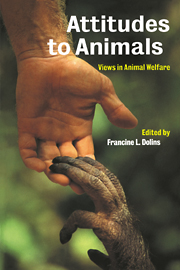Book contents
- Frontmatter
- Contents
- List of contributors
- Acknowledgements
- Part I Attitudes to animals
- Part II Animal awareness
- Part III Animal welfare
- Part IV Research and education
- 12 Humane education: the role of animal-based learning
- 13 ‘Minding animals’: the role of animals in children's mental development
- 14 Alternatives to using animals in education
- 15 Animals in scientific education and a reverence for life
- Part V Epilogue: the future of wild animals
- Index
12 - Humane education: the role of animal-based learning
Published online by Cambridge University Press: 16 November 2009
- Frontmatter
- Contents
- List of contributors
- Acknowledgements
- Part I Attitudes to animals
- Part II Animal awareness
- Part III Animal welfare
- Part IV Research and education
- 12 Humane education: the role of animal-based learning
- 13 ‘Minding animals’: the role of animals in children's mental development
- 14 Alternatives to using animals in education
- 15 Animals in scientific education and a reverence for life
- Part V Epilogue: the future of wild animals
- Index
Summary
Introduction
The anthropologist Claude Lévi-Strauss (1965) is well known for his statement that human societies revere totemic animals not because they are good eating, but because they are good thinking. His work points out many ways in which humans understand the world and their place in it through their knowledge of the animals around them. Indeed, this way of knowing the world through the animals around us may be considered one of the human ‘universals’ (cf. Brown, 1991).
Furthermore, human societies rely on this animal-derived information in several characteristic ways – symbolic, formative, cautionary, and observational – and we recognize these in the many ways animals are represented in our own culture. Löfgren (1985) describes the post-bourgeois development of the idea of ‘animality’ that viewed the animal world as degenerate and immoral, and established a hierarchy of the animal kingdom based on the tendency to express certain ‘good’ characteristics. In a similar vein, we know the cautionary tales of Aesop and Beatrix Potter in which the prominent characters are mice, foxes, or turtles and hares (Kale, 1993). These views became the basis for formative lessons about right and wrong.
Gillespie and Mechling (1987) show the elevation of certain salient characteristics of animals so that these animals stand as symbols of the character of a people or as mascots. In the US they trace the symbolic rise of the bald eagle and the concomitant decline of the wild turkey as an example of this process. Trickster stories in which a smaller, weaker, or slower protagonist defeats a more powerful opponent by use of his wits are also common across cultures (e.g. Frey, 1987).
- Type
- Chapter
- Information
- Attitudes to AnimalsViews in Animal Welfare, pp. 167 - 185Publisher: Cambridge University PressPrint publication year: 1999



